Summary
In SaaS, onboarding makes or breaks retention. A confusing first experience drives churn, while clear navigation, early wins, and personalized flows turn new sign-ups into loyal users. By focusing on simplicity, feedback, and measurable outcomes, onboarding becomes more than a setup — it’s a growth engine.
First impressions matter, especially in SaaS. For many users, onboarding is the first real interaction with your product, and it can determine whether they’ll stick around or churn before they ever experience your software’s value. According to Business Dasher, it costs 5-25 times more to acquire a new customer than to retain an existing one. If first-time user experience (FTUE) fails, all your acquisition efforts go to waste.
A clunky process creates frustration and drop-offs. But a seamless, guided experience that delivers quick wins converts sign-ups into long-term customers.Therefore, let’s explore why onboarding matters more than ever and what can be done.
Why SaaS Onboarding Must Start at the Product Development Stage
As a custom software development company, we have experienced many product development projects and have some thoughts to share. You need to understand that the moment a user signs up for your product, they begin a journey. For too long, businesses have treated onboarding as a post-launch add-on — a separate flow of tutorials, tooltips, and emails designed to fix adoption problems after the product has been built. However, this approach is fundamentally flawed. If your product is difficult to understand or its value is not immediately obvious, no amount of retrospective “user activation” can fully overcome the underlying design flaws. The truth is, the quality of your user beginning journey is a direct reflection of your product development strategy.
1. Product Architecture Shapes User Loyalty
Effective product adoption is not about teaching; it’s about facilitating discovery. This mindset must be present from the very first wireframe. When development begins, the focus shouldn’t just be on ‘Does this feature work?‘ but you should also ask ‘Can a first-time user immediately see the value of this feature?‘
According to Wyzowl, 86% of people say they’d be more loyal to a business that invests in onboarding. Instead of users only scratching the surface, it encourages them to explore core features and understand how the product can fit into their daily workflow. Therefore, the product’s core features must be inherently discoverable and intuitive. This requires product managers, UX/UI designers, and developers to collaboratively define the “Aha!” moment — the point where a user first realizes the product’s core value — and then to engineer the application’s architecture to push the user toward it as quickly and seamlessly as possible.
This means:
- Minimizing Time-to-Value: Reducing unnecessary steps, clicks, or cognitive load between signup and successful first use;
- Embedding Guidance: Integrating contextual help, empty states, and progressive disclosure directly into the UI, rather than relying on external guides;
- Prioritizing Core Actions: Making the most critical functions prominent and easily accessible, ensuring new users aren’t overwhelmed by secondary features.
Read Also The Intricate Art of Maximizing Value. How To Make Every Coin Spent Worth its Weight In Gold
2. Onboarding-First Development Saves Time, Cost, and Users
Baking the implementation phase into the product’s foundation requires a specialized approach. It moves beyond simple coding and into holistic user experience engineering. Engaging dedicated product development services ensures that user adoption is not an afterthought but a central design goal.
True efficiency comes from avoiding costly rework. Trying to bolt a complex onboarding system onto an existing rigid product structure is expensive and often results in a subpar experience. By adopting an onboarding-first methodology during the initial product development services phase, your team can:
- Establish a Data Layer: Build the necessary hooks to track user progress, identify drop-off points, and personalize the initial experience — all essential components for optimization later on;
- Align Design and Engineering: Ensure the UX/UI is designed with implementable, contextual guides, preventing a disconnect between the visual mockups and the final, functional application;
- Validate Early: Use early prototypes and MVPs to test the onboarding flow itself, not just the features, allowing for critical adjustments before committing to large-scale development.
Read Also Fast and Furious: How to Develop Valid Prototype in Less Than 5 Days Following MVP Design Sprint?
3. First Session Can Make or Break SaaS Growth
In the competitive landscape of subscription-based software, churn is the biggest threat. For modern SaaS application development, the initial user experience is the primary driver of adoption and retention. If a user can’t figure out how to use a web application within the first few minutes, they will simply cancel their trial and move to a competitor — a few dollars for a competitor’s app is a much smaller investment for a user than the hours required to learn a complicated tool.
Successful SaaS applications are characterized by their elegance and simplicity. This simplicity is an engineered illusion. It’s the result of development teams intentionally structuring the application flow to guide the user naturally. By focusing on setup experience during the SaaS application development phase, businesses can:
- Improve Trial-to-Paid Conversion: A smooth, value-driven first session is the most effective conversion tool;
- Reduce Support Load: Well-designed products inherently require less customer support, freeing up resources and lowering operational costs;
- Boost Retention and Advocacy: Users who successfully achieve their goals early on are more likely to become long-term, loyal customers.
In conclusion, viewing onboarding as a developmental stage rather than a post-release task transforms the process from damage control into a strategic competitive advantage. It ensures that the product you launch is not just functional, but inherently adoptable.
Read Also The Power of Rapid Application Development: When Speed Meets Flexibility
Common SaaS Onboarding Challenges and How Famous Companies Dealt With Them
SaaS onboarding isn’t always smooth sailing. Even the most promising products can lose users if the first experience feels confusing, overwhelming, or slow. Let’s look at the most common challenges companies face during onboarding — and why addressing them early makes all the difference.
Overwhelming the User with Complexity
Many SaaS products try to show everything at once (full dashboards, advanced settings, integrations) before the user even understands the basics. This “information overload” makes product adoption feel like an exam rather than an exploration. Instead of feeling empowered, users feel overwhelmed and quit. Therefore, you need to avoid this.
For example, Instagram’s onboarding succeeded because it delivered quick wins. In the early days, when you uploaded a photo, the app started uploading it before you hit confirm. This small UX tweak shaved off seconds of wait time and gave users a sense of instant gratification.

Instagram co-founder Kevin Systrom shares how they made Instagram fast
Lack of Intuitive Navigation
One of the biggest UX onboarding blockers is confusing navigation. If users can’t figure out where to click, how to complete a task, or what the next step is, frustration builds. Pretty visuals don’t solve this, clarity and flow do.
For example, Slack solved this problem with Slackbot. Instead of throwing users into a busy workspace and leaving them to guess, Slackbot acts as a friendly guide, prompting users to send their first message, set reminders, or adjust settings. This conversational approach makes the implementation phase feel natural and interactive, while quietly teaching users how to navigate the app.
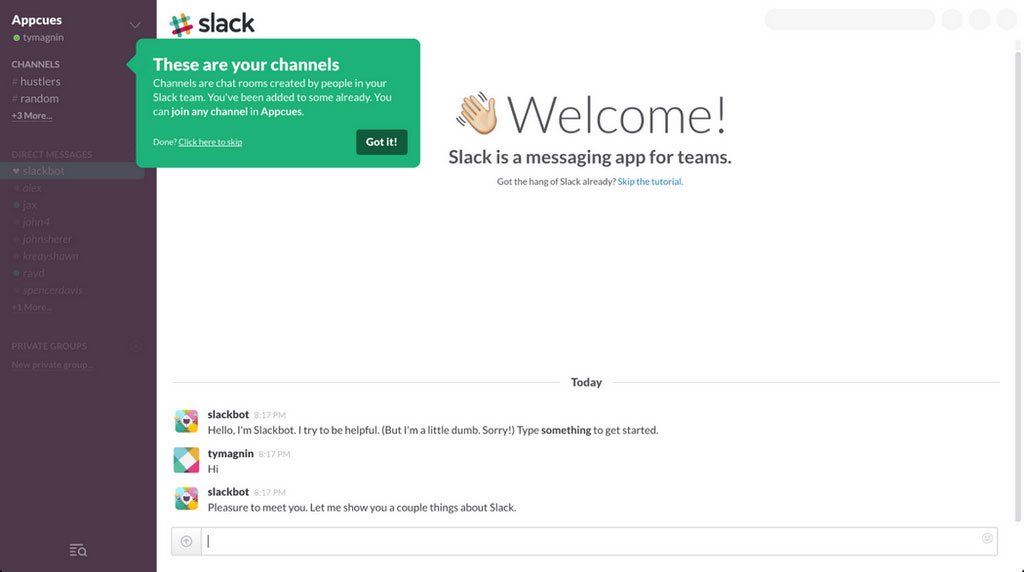
Source: GoodUX
No Clear Path to Value
Too many SaaS tools focus on showing features, not outcomes. The user logs in, sees a cluttered interface, and has no idea how the product actually helps them to achieve their goal. Without early wins — small, measurable results within the first session — users lose motivation. But what they need is a clear path.
For example, Canva does this well. Instead of forcing new users to explore every feature, it prompts them to create something small right away — like a simple social post. By completing a tangible task, users immediately see the tool’s value.
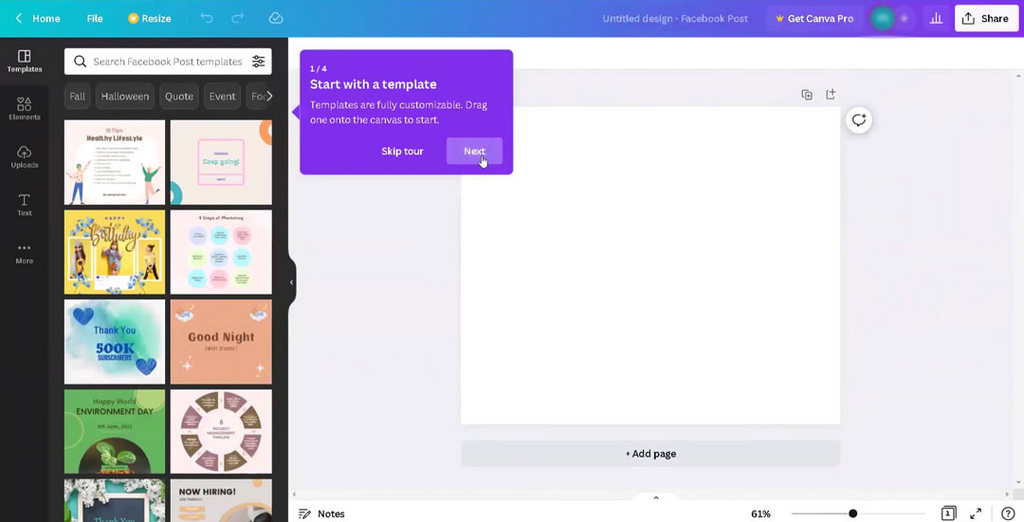
Canva’s introductory tour after the signup
One-Size-Fits-All Onboarding
Not all users are the same. A beginner logging in for the first time needs hand-holding. An advanced user switching from a competitor just wants to skip ahead. Generic activation flow frustrates both groups. Personalization is critical.
For example, Notion demonstrates this approach nicely. It offers templates and a guided tour for beginners, but power users can skip directly to setting up advanced workspaces. This flexibility ensures different user types both feel supported.
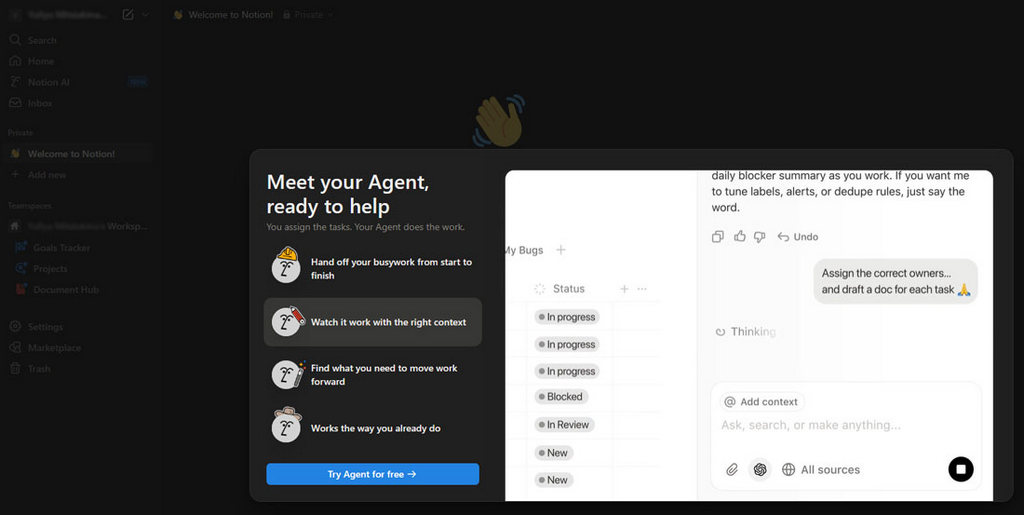
Notion’s suggestion to try the integrated AI Agent as part of the personalized onboarding process
Skipping Feedback Loops
SaaS onboarding often ignores direct user feedback. Teams may assume their flows are intuitive but rarely validate with real users. Therefore, getting feedback from users is vital.
For example, working on one of our SaaS projects, we helped a client struggling with user adoption of their legacy system. The problem wasn’t the lack of features — in fact, the platform was powerful — but its outdated UI and confusing navigation created friction from the very first login. New users felt overwhelmed, couldn’t find what they needed, and often gave up before reaching the product’s real value.
Our team connected Hotjar to monitor user behavior and identify sticking points in product adoption. Heatmaps and session recordings revealed exactly where users dropped off — often in navigation menus. This kind of data-driven feedback is essential to iterate onboarding design.
This experience highlights a critical SaaS onboarding truth: users don’t leave because your product is weak, they leave because it feels hard to use. Poor UX creates the same drop-offs as clunky onboarding flows. That’s why investing in intuitive navigation, progressive disclosure, and early wins isn’t just a “nice-to-have” — it’s essential to making your product stick.
Read more about the project: How to Redesign a UI Without Losing Usability: A Case Study on Modernizing a Legacy App
The SaaS Onboarding Checklist: Best Practices, Key Metrics to Track, and Lessons from Our Projects
So how do you fix the challenges in your own product? Let’s walk through best practices based on our experience and on what leading SaaS companies apply to make first-time user experience smooth, engaging, and effective.
Best Practices for Effective SaaS Onboarding
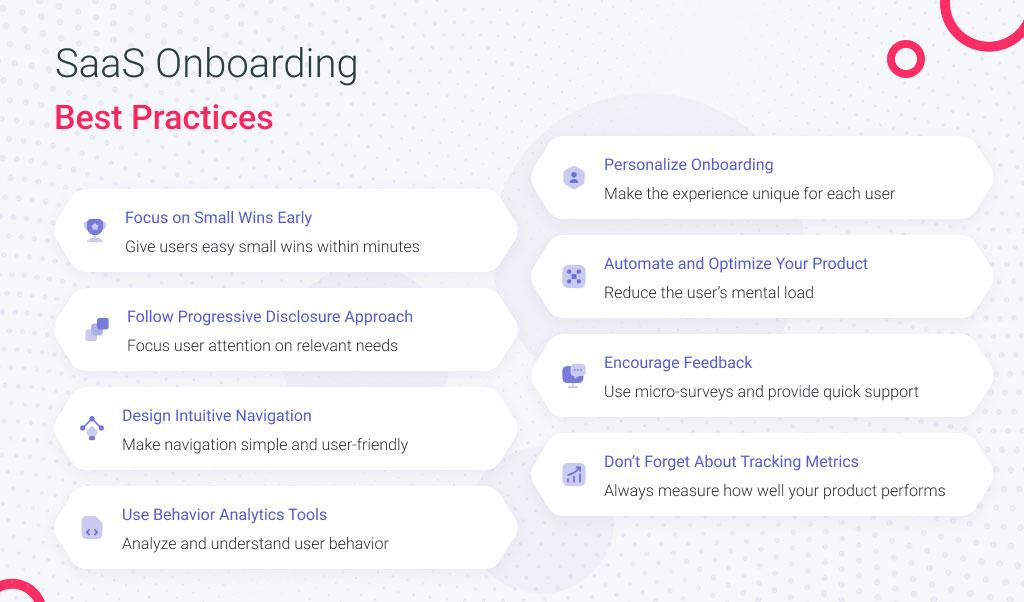
1. Focus on Small Wins Early
Your onboarding flow should give users achievements within minutes. For example integrate:
- A project management tool prompting users to create their first task immediately;
- A design app letting users drag and drop elements before any setup;
- An email automation tool showing a sample campaign ready to edit.
Each early win builds confidence and reduces the risk of churn.
2. Keep It Simple (Progressive Disclosure)
Instead of dumping all features at once, use progressive disclosure: show only what the user needs at the moment. Don’t explain advanced integrations during the implementation phase. Instead, focus user attention on creating a workspace, inviting teammates, and sending the first message — everything a beginner needs. Only after the user feels comfortable, more advanced options may appear.
3. Design Intuitive Navigation
Pretty UI is not enough — clarity is key. Navigation should feel natural, guiding the user step by step without requiring instructions. So, the best practices to follow would be to:
- Limit menu items to essentials during onboarding;
- Use contextual tooltips instead of long tutorials;
- Offer checklists with clear progress indicators.
4. Leverage Behavioral Analytics
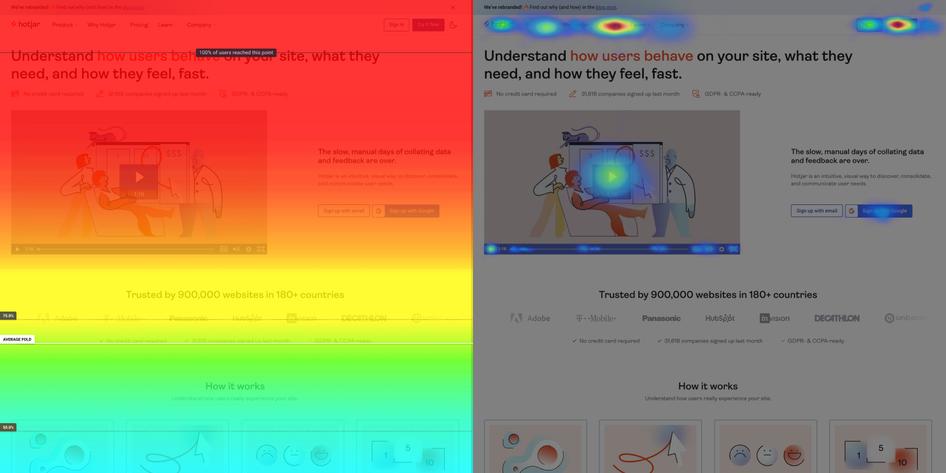
Hotjar using its own product for interaction design
Without real data, onboarding improvements are guesswork. Tools like Hotjar, FullStory, or Mixpanel help SaaS teams understand user behavior:
- Where users get stuck;
- Which steps cause drop-offs;
- Which features are most/least used.
Armed with this, you can redesign flows based on actual pain points, not assumptions.
5. Personalize Onboarding
Not all users have the same goals. Personalization helps to reduce friction and increase engagement. The ways to personalize may include:
- Asking users their role or goal during signup, then tailor onboarding accordingly;
- Offering a “skip tour” option for advanced users;
- Providing industry-specific templates or examples.
6. Automate Where Possible
Automation reduces the user’s mental load. Remember how Instagram pre-uploaded photos before confirmation — that kind of invisible optimization matters. Other solutions that can be used include:
- Auto-populating sample data in dashboards;
- Pre-configuring integrations based on signup source;
- Auto-saving progress so users don’t lose work.
7. Encourage Feedback
Onboarding isn’t static — it evolves. So, always gather feedback:
- Use micro-surveys (“Was this step clear?”);
- Provide quick support chat access;
- Review analytics regularly.
The faster you spot friction, the quicker you can resolve it.
8. Don’t Forget About Tracking Metrics
Even the best-designed onboarding flow won’t mean much if you can’t measure how well it performs. Tracking the right metrics will help you to spot friction points, understand user behavior, and continually optimize for better adoption and retention. Here are the key SaaS onboarding metrics worth monitoring:
| Metric | Question to ask | Benchmark / Average | Positive effect | Negative effect |
| Time-to-Value (TTV) | How quickly do new users reach their first “aha moment”? | Best-in-class: <1 day
Average SaaS: 1–2 weeks |
Shorter TTV means your onboarding guides users to value faster, boosting satisfaction and long-term engagement | Longer TTV means users struggle to see value, leading to frustration and higher risk of churn |
| Activation Rate | What is the % of users who complete critical onboarding actions (e.g., uploading data, sending their first message, etc.)? | Strong: 40–60%+ activation
Average SaaS: 20–40% |
High activation rate signals that the product adoption is driving users toward meaningful engagement | Low activation means users stall early and don’t connect with the product’s core value |
| First-Week Retention | Do users return and engage within the first 7 days? | Healthy: 40–50% (varies by product type) | High retention means that onboarding creates momentum that keeps users coming back | Drop-offs after a few days suggest poor onboarding experience or weak product value discovery |
| Feature Adoption | Which features are being adopted or ignored? | Top features: 60–80% adoption
Secondary features: 20–40% |
High adoption of core features means onboarding is highlighting functionality that delivers real value | Low adoption shows users miss or avoid important features, reducing overall satisfaction and retention |
| Churn During Onboarding | Where do you lose users exactly? | Acceptable churn: <20% during onboarding
High risk: 30%+ |
Low churn during setup experience means a smooth, intuitive process keeps users engaged | High churn indicates friction, confusion, or poor guidance during onboarding, leading to early exits |
Conclusion: Onboarding as a Growth Engine
SaaS onboarding is more than just a setup process — it’s the foundation of long-term customer success. A thoughtful, well-structured first user journey reduces early churn, accelerates time-to-value, and turns new users into loyal advocates.
Companies that invest in intuitive flows, small early wins, and continuous feedback don’t just make users happy — they build products that become an indispensable part of daily workflows. So if you want to focus on clarity, personalization, and measurable outcomes, contact us, and we can help you to develop a user-friendly and intuitive system.
FAQ
Onboarding is about helping users quickly realize the value of your product — guiding them through setup, core features, and first wins. Customer training goes deeper, often covering advanced functionality or long-term use cases. Think of onboarding as the first impression, and training as ongoing education that may be helpful at a later date.
It depends on the product and audience. Automated options (tooltips, product tours, checklists) works well for self-serve SaaS and smaller teams. But for complex B2B platforms, adding a human touch (success managers, kickoff calls) can reduce friction and speed up adoption. A hybrid approach is often most effective.
Any SaaS product with more than a few simple functions benefits from onboarding. Project management tools, CRMs, financial apps, and workflow automation platforms all have learning curves. Even consumer-facing apps often use lightweight onboarding to reduce drop-offs. It all depends on the goals you have.
Contextual onboarding delivers guidance inside the app at the exact moment a user needs it. Instead of dumping instructions upfront, it nudges users as they perform actions (e.g., “Upload your first file here”). Use it to reduce overwhelm and help users learn by doing.
The faster the better — your goal is to shorten Time-to-Value. Ideally, users should reach their “aha moment” within minutes. More complex SaaS platforms may require phased onboarding, but the first value should still come quickly to build trust and engagement.